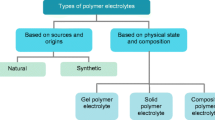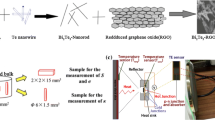Abstract
In this work, we have synthesized and characterized a series of Donor−Acceptor (D–A) conjugated polymers (PffBT4T-2DT) with different molecular weights, introduced a microwave method into the synthesis process, shortened the experimental cycle time by over 5 days and increased the molecular weight of the polymers. The conditions affecting the molecular weight of the polymers were investigated. It is shown that the prepared conjugated polymers have excellent thermal stability and solubility, higher molecular weight polymers have broader absorption spectra and stronger inter-chain aggregation, and the strong aggregation ability of polymer chains is dependent on molecular weight and solution temperature, with lower polymer molecular weight and higher solution temperature both causing weaker polymer chain aggregation. The polymer films of the three molecular weights have a uniform surface with a roughness of about 0.83 and good crystallinity. Transistor test results show that the higher molecular weight polymers perform better when applied to field effect transistors, with mobilities as high as 0.124 cm2 V−1 s−1 and threshold voltages as low as 2 V.
Graphical Abstract
A series of donor-acceptor conjugated polymers (PffBT4T-2DT) with different molecular weights were synthesized by introducing the microwave method. The thermodynamic, optical, electrochemical and photovoltaic properties of the polymers were characterized, and the effect of molecular weight on the performance of organic field effect transistors (OFETs) was investigated.









Similar content being viewed by others
References
Kim M, Ryu S U, Park S A, Choi K, Kim T, Chung D and Park T 2019 Donor–Acceptor‐Conjugated Polymer for High‐Performance Organic Field‐Effect Transistors: A Progress Report Adv. Funct. Mater. 30
Podzorov V 2013 Organic single crystals: Addressing the fundamentals of organic electronics MRS Bull. 38 15
Sirringhaus H 2014 25th anniversary article: Organic field-effect transistors: the path beyond amorphous silicon Adv. Mater. 26 1319
Wang C, Dong H, Hu W, Liu Y and Zhu D 2012 Semiconducting pi-conjugated systems in field-effect transistors: a material odyssey of organic electronics Chem. Rev. 112 2208
Wu H, Ying L, Yang W and Cao Y 2009 Progress and perspective of polymer white light-emitting devices and materials Chem. Soc. Rev. 38 3391
Xiao L, Chen Z, Qu B, Luo J, Kong S, Gong Q and Kido J 2011 Recent progresses on materials for electrophosphorescent organic light-emitting devices Adv. Mater. 23 926
Cheng P, Li G, Zhan X and Yang Y 2018 Next-generation organic photovoltaics based on non-fullerene acceptors Nat. Photon. 12 131
Janssen R A and Nelson J 2013 Factors limiting device efficiency in organic photovoltaics Adv. Mater. 25 1847
Lu L, Zheng T, Wu Q, Schneider AM, Zhao D and Yu L 2015 Recent Advances in Bulk Heterojunction Polymer Solar Cells Chem. Rev. 115 12666
Baeg KJ, Caironi M and Noh YY 2013 Toward printed integrated circuits based on unipolar or ambipolar polymer semiconductors Adv. Mater. 25 4210
Chortos A, Liu J and Bao Z 2016 Pursuing prosthetic electronic skin Nat. Mater. 15 937
Fukuda K, Takeda Y, Yoshimura Y, Shiwaku R, Tran L T, Sekine T, et al. 2014 Fully-printed high-performance organic thin-film transistors and circuitry on one-micron-thick polymer films Nat. Commun. 5 4147
Tran H, Feig V R, Liu K, Zheng Y and Bao Z 2019 Polymer Chemistries Underpinning Materials for Skin-Inspired Electronics Macromolecules 52 3965
Yao Y, Dong H and Hu W 2016 Charge Transport in Organic and Polymeric Semiconductors for Flexible and Stretchable Devices Adv. Mater. 28 4513
He X, Mukherjee S, Watkins S, Chen M, Qin T, Thomsen L, et al. 2014 Influence of Fluorination and Molecular Weight on the Morphology and Performance of PTB7:PC71BM Solar Cells J. Phys. Chem. C 118 9918
Li W, Yang L, Tumbleston J R, Yan L, Ade H and You W 2014 Controlling molecular weight of a high efficiency donor-acceptor conjugated polymer and understanding its significant impact on photovoltaic properties Adv. Mater. 26 4456
Lu L, Zheng T, Xu T, Zhao D and Yu L 2015 Mechanistic Studies of Effect of Dispersity on the Photovoltaic Performance of PTB7 Polymer Solar Cells Chem. Mater. 27 537
Ma W, Yang G, Jiang K, Carpenter J H, Wu Y, Meng X, McAfee T, Zhao J, Zhu C, Wang C, Ade H and Yan H 2015 Influence of Processing Parameters and Molecular Weight on the Morphology and Properties of High-Performance PffBT4T-2OD: PC71BM Organic Solar Cells Adv. Energy Mater. 5
Vangerven T, Verstappen P, Drijkoningen J, Dierckx W, Himmelberger S, Salleo A, et al. 2015 Molar Mass versus Polymer Solar Cell Performance: Highlighting the Role of Homocouplings Chem. Mater. 27 3726
Arunagiri L, Zhang G, Hu H, Yao H, Zhang K, Li Y, Chow P C Y, Ade H and Yan H 2019 Temperature‐Dependent Aggregation Donor Polymers Enable Highly Efficient Sequentially Processed Organic Photovoltaics Without the Need of Orthogonal Solvents Adv. Funct. Mater. 29
Chen S, Wang Y, Zhang L, Zhao J, Chen Y, Zhu D, et al. 2018 Efficient Nonfullerene Organic Solar Cells with Small Driving Forces for Both Hole and Electron Transfer Adv. Mater. 30 e1804215
Chen Z, Cai P, Chen J, Liu X, Zhang L, Lan L, et al. 2014 Low band-gap conjugated polymers with strong interchain aggregation and very high hole mobility towards highly efficient thick-film polymer solar cells Adv. Mater. 26 2586
Chochos C L, Spanos M, Katsouras A, Tatsi E, Drakopoulou S, Gregoriou V G and Avgeropoulos A 2019 Current status, challenges and future outlook of high performance polymer semiconductors for organic photovoltaics modules Prog. Polym. Sci. 91 51
Liao X, Zhang L, Chen L, Hu X, Ai Q, Ma W and Chen Y 2017 Room temperature processed polymers for high-efficient polymer solar cells with power conversion efficiency over 9% Nano Energy 37 32
Liu J, Ma L-K, Sheong F K, Zhang L, Hu H, Zhang J-X, et al. 2018 Carboxylate substitution position influencing polymer properties and enabling non-fullerene organic solar cells with high open circuit voltage and low voltage loss J. Mater. Chem. A 6 16874
Albrecht S, Janietz S, Schindler W, Frisch J, Kuipers J, Kniepert J, et al. 2012 Fluorinated copolymer PCPDTBT with enhanced open-circuit voltage and reduced recombination for highly efficient polymer solar cells J. Am. Chem. Soc. 134 14932
Xiao J, Jia X, Duan C, Huang F, Yip H L and Cao Y 2021 Surpassing 13% Efficiency for Polythiophene Organic Solar Cells Processed from Nonhalogenated Solvent Adv. Mater. 33 e2008158
Yao H, Li Y, Hu H, Chow P C Y, Chen S, Zhao J, Li Z, Carpenter J H, Lai J Y L, Yang G, Liu Y, Lin H, Ade H and Yan H 2017 A Facile Method to Fine‐Tune Polymer Aggregation Properties and Blend Morphology of Polymer Solar Cells Using Donor Polymers with Randomly Distributed Alkyl Chains Adv. Energy Mater. 8
You J, Dou L, Yoshimura K, Kato T, Ohya K, Moriarty T, et al. 2013 A polymer tandem solar cell with 10.6% power conversion efficiency Nat. Commun. 4 1446
Zhou H, Yang L, Stuart A C, Price S C, Liu S and You W 2011 Development of fluorinated benzothiadiazole as a structural unit for a polymer solar cell of 7% efficiency Angew. Chem. 50 2995
Hu H, Chow PCY, Zhang G, Ma T, Liu J, Yang G and Yan H 2017 Design of Donor Polymers with Strong Temperature-Dependent Aggregation Property for Efficient Organic Photovoltaics Acc. Chem. Res. 50 2519
Kim J-H, Shin S A, Park J B, Song C E, Shin W S, Yang H, et al. 2014 Fluorinated Benzoselenadiazole-Based Low-Band-Gap Polymers for High Efficiency Inverted Single and Tandem Organic Photovoltaic Cells Macromolecules 47 1613
Liu Y, Zhao J, Li Z, Mu C, Ma W, Hu H, et al. 2014 Aggregation and morphology control enables multiple cases of high-efficiency polymer solar cells Nat. Commun. 5 5293
An C, Li M, Marszalek T, Li D, Berger R, Pisula W and Baumgarten M 2014 Thiadizoloquinoxaline-Based Low-Bandgap Conjugated Polymers as Ambipolar Semiconductors for Organic Field Effect Transistors Chem. Mater. 26 5923
Cardona C M, Li W, Kaifer A E, Stockdale D and Bazan G C 2011 Electrochemical considerations for determining absolute frontier orbital energy levels of conjugated polymers for solar cell applications Adv. Mater. 23 2367
Zhu Y, Zhao F, Wang W, Li Y, Zhang S and Lin Y 2022 Exciton Binding Energy of Non‐Fullerene Electron Acceptors Adv. Energy Sustain. Res. 3
Acknowledgments
This work was financially supported by the National Natural Science Foundation of China (No. 32072297), Jiangsu Collaborative Innovation Centre of Technology and Material of Water Treatment, the Opening Project of Key Laboratory of Microelectronic Devices & Integrated Technology, Institute of Microelectronics, Chinese Academy of Sciences.
Funding
National Natural Science Foundation of China, 32072297, Wanzhen Xu.
Author information
Authors and Affiliations
Corresponding authors
Supplementary Information
Below is the link to the electronic supplementary material.
Rights and permissions
About this article
Cite this article
Yang, W., Li, P., Fang, Q. et al. Synthesis and Photoelectric Properties of D-A Conjugated Polymers of Benzothiadiazoles with Different Molecular Weights. J Chem Sci 135, 110 (2023). https://doi.org/10.1007/s12039-023-02226-6
Received:
Revised:
Accepted:
Published:
DOI: https://doi.org/10.1007/s12039-023-02226-6




